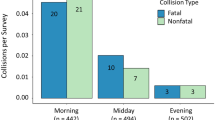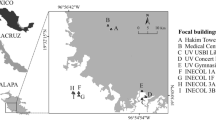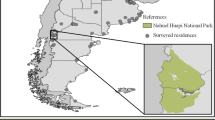Abstract
Bird collisions with buildings are an increasing concern and yet understanding the factors contributing to collisions at the species level remains largely unknown. This gap in our knowledge of species-specific strike patterns hinders the development of accurate estimates for the impact of death-by-collision on bird populations and impedes on our ability to minimize its effects. Our study offers the first examination of the impact of environmental variables on bird-window collisions at the species level. The Fatal Light Awareness Program Canada collected bird-window collision data in three distinct regions of Toronto, Canada during the migratory season of the years 2009 and 2010. Our results indicated that building percent window cover, exposed habitat cover, and cover of built structures significantly affect bird-window collisions. Multivariate analyses showed that the bird species that collided with buildings surrounded by a high level of urban greenery are species that typically occur in forested habitats and are foliage gleaners. In contrast, species that collided with buildings surrounded by a higher level of urbanization are species that typically occur in open woodland and are ground foragers. These results suggest that the composition of bird species colliding with buildings across various regions of the Greater Toronto Area is influenced by the local bird species community composition, by the configuration of the surrounding landscape, and by the levels of greenery around the buildings.





Similar content being viewed by others
References
Balogh AL, Ryder TB, Marra PP (2011) Population demography of Gray Catbirds in the suburban matrix: sources, sinks and domestic cats. J Ornithol 152:717–726
Banks RC (1976) Reflective plate glass—a hazard to migrating birds. Bioscience 26:414
Bayne S, Rawson-Clark E (2012) Factors influencing the annual risk of bird–window collisions at residential structures in Alberta, Canada. Wildl Res 39:583–592
Beissinger SR, Osborne DR (1982) Effects of urbanization on avian community organization. Condor 84:75–83
Bishop CA, Brogan JM (2013) Estimates of avian mortality attributed to vehicle collisions in Canada. Avian Conserv Ecol 8:2
Blair RB (1996) Land use and avian species diversity along an urban gradient. Ecol Appl 6:506–519
Blair R (2004) The effects of urban sprawl on birds at multiple levels of biological organization. Ecol Soc 9:2
Blancher P (2013) Estimated number of birds killed by house cats (Felis catus) in Canada. Avian Conserv Ecol 8:3
Borden WC, Lockhart OM, Jones AW, Lyons MS (2010) Seasonal, taxonomic, and local habitat components of bird-window collisions on an urban university campus in Cleveland, OH. Ohio J Sci 110:44–52
Calvert AM, Bishop CA, Elliot RD, Krebs EA, Kydd TM, Machtans CS, Robertson GJ (2013) A synthesis of human-related avian mortality in Canada. Avian Conserv Ecol 8:11
Chase JF, Walsh JJ (2006) Urban effects on native avifauna: a review. Landsc Urban Plan 74:46–69
Clergeau P, Savard JPL, Mennechez G, Falardeau G (1998) Bird abundance and diversity along an urban–rural gradient: a comparative study between two citites on different continents. Condor 100:413–425
Clergeau P, Jokimäki J, Snep R (2006) Using hierarchical levels for urban ecology. Trends Ecol Evol 21:660–661
Crawford RL (1981) Bird kills at a lighted man-made structure: often on nights close to a full moon. Am Bird 35:913–914
Diehl RH, Larkin RP, Black JE (2003) Radar observations of bird migration over the Great Lakes. Auk 120:278–290
Dunn EH (1993) Bird mortality from striking residential windows in winter (mortalidad de aves ocasionada por choques con ventanas durante el invierno). J Field Ornithol 65:302–309
Edgar DR, Kershaw GP (1994) The density and diversity of the bird populations in three residential communities in Edmonton, Alberta. Can Field Nat 108:156–161
Evans KL, Newson SE, Gaston KJ (2009) Habitat influences on urban avian assemblages. Ibis 151:19–39
Flather C, Sauer J (1996) Using landscape ecology to test hypotheses about large-scale abundance patterns in migratory birds. Ecology 77:28–35
Fontana S, Sattler T, Bontadina F, Moretti M (2011) How to manage the urban green to improve bird diversity and community structure. Landsc Urban Plan 101:278–285
Fuller RA, Irvine KN, Devine-Wright P, Warren PH, Gaston KJ (2007) Psychological benefits of green space increase with biodiversity. Biol Lett 3:390–394
Gauthreaux SA (1980) Animal migration, orientation, and navigation. Academic, New York
Gauthreaux SA, Belser CG (2006) Effect of artificial night lighting on migrating birds. In: Rich C, Longcore T (eds) Ecological consequences of artificial night lightning. Island Press, Washington, pp 67–93
Gelb Y, Delacretaz N (2009) Windows and vegetation: primary factors in Manhattan bird collisions. Northeast Nat 16:455–470
Hager SB, Craig ME (2014) Bird-window collisions in the summer breeding season. Peer J 2:e460
Hager SB, Trudell H, Mckay KJ, Crandall SM, Mayer L (2008) Bird density and mortality at windows. Wilson J Ornithol 120:550–564
Hager SB, Cosentino BJ, McKay KJ, Monson C, Zuurdeeg W, Belvins B (2013) Window area and development drive spatial variation in bird-window collisions in an urban landscape. PLoS ONE 8(1):e53371
Herbert AD (1970) Spatial disorientation in birds. Wilson Bull 82:400–419
Jackson DA (1997) Compositional data in community ecology: the paradigm or peril of proportions? Ecology 78:929–940
Jackson DA, Harvey HH (1989) Biogeographic associations in fish assemblages: local versus regional processes. Ecology 70:1472–1484
Kalinowski RS, Johnson MD (2010) Influence of suburban habitat on a wintering bird community in coastal northern California. Condor 112:274–282
Klem D (1989) Bird-window collisions. Wilson Bull 101:606–620
Klem D (1990a) Collisions between birds and windows: mortality and prevention. J Field Ornithol 61:120–128
Klem D (1990b) Bird Injuries, cause of death, and recuperation from collisions with windows (Heridas, Causas de Muerte y Restablecimiento de Aves que Chocan con Ventanas). J of Field Ornithol 61:115–119
Klem D, Farmer CJ, Delacretaz N, Gelb Y, Saenger P (2009) Architectural and landscape risk factors associated with bird-glass collisions in an urban environment. Wilson J Ornithol 121:126–134
Lancaster RK, Rees WE (1979) Bird communities and the structure of urban habitats. Can J Zool 57:2358–2368
Lepczyk CA, Mertig AG, Liu J (2003) Landowners and cat predation across rural-to-urban landscapes. Biol Conserv 115:191–201
Longcore T, Smith PA (2013) On avian mortality associated with human activities. Avian Conserv Ecol 8:1
Longcore T, Rich C, Mineau P, MacDonald B, Bert DG, Sullivan LM, Mutrie E, Gauthreaux Jr.SA, Avery ML, Crawford RL, Manville II AM, Travis ER, Drake D (2012) An estimate of avian mortality at communication towers in the United States and Canada. PLoS ONE 7(4) doi:10.1371/journal.pone.0034025
Loss SR, Will T, Marra PP (2012) Direct human-caused mortality of birds: Improving quantification of magnitude and assessment of population impact. Front Ecol Environ 10:357–364
Loss SR, Will T, Loss SS, Marra PP (2014) Bird-building collisions in the United States: estimates of annual mortality and species vulnerability. Condor: Ornithol Appl 116:8–23
MacGregor-Fors I, Schondube JE (2011) Gray vs. green urbanization: relative importance of urban features for urban bird communities. Basic Appl Ecol 12:372–381
Machtans CS, Wedeles CHR, Bayne EM (2013) A first estimate for Canada of the number of birds killed by colliding with building windows. Avian Conserv Ecol 8:6
Martin GR (2011) Understanding bird collisions with man-made objects: a sensory ecology approach. Ibis 153:239–254
Melles S, Glenn S, Martin K (2003) Urban bird diversity and landscape complexity: species-environment associations along a multiscale habitat gradient. Conserv Ecol 7:5
Minor E, Urban D (2010) Forest bird communities across a gradient of urban development. Urban Ecosyst 13:51–71
Moore FR, Gauthreaux SA, Kerlinger P, Simons TR (1995) Habitat requirements during migration: important link in conservation. In: Martin TE, Finch DM (eds) Ecology and management of neotropical migratory birds: a synthesis and review of critical issues. Oxford University Press, New York, pp 121–144
Mumme RL, Schoech SJ, Woolfenden GE, Fitzpatrick JW (2000) Life and death in the fast lane: demographic consequences of road mortality in the Florida Scrub-Jay. Conserv Biol 14:501–512
Nenadic O, Greenacre M (2007) Correspondence analysis in R, with two- and three-dimensional graphics: the ca package. J Stat Softw 20:1–13
Newton I (2008) The migration ecology of birds. Academic, London
Dougan & Associates and North–south Environmental (2009) Migratory Birds of Toronto. Report for City of Toronto
Ogden LJE (1996) Collision course: The hazards of lighted structures and windows to migrating birds. University of Nebraska – Lincoln. Retrieved from http://digitalcommons.unl.edu/flap/3/
Oksanen J, Blanchet FG, Kindt R, Legendre P, Minchin PR, O’Hara RB, Simpson GL, Solymos P, Stevens MHH, Wagner H (2013) vegan: Community Ecology Package. R package version 2.0-10. http://CRAN.R-project.org/package=vegan
Pennington DN, Hansel J, Blair RB (2008) The conservation value of urban riparian areas for landbirds during spring migration: land cover, scale, and vegetation effects. Biol Conserv 141:1235–1248
Petit DR (2000) Habitat use by landbirds along nearctic-neotropical migration routes: implications for conservation of stopover habitats. Stud Avian Biol 20:15–33
R Core Team (2013) R: A language and environment for statistical computing. R Foundation for Statistical Computing, Vienna, Austria. URL http://www.R-project.org/
Riffell SK, Keas BE, Burton TM (2003) Birds in North American Great Lakes coastal wet meadows: is landscape context important? Landsc Ecol 18:95–111
Robertson BA, Hutto RL (2006) A framework for understanding ecological traps and an evaluation of existing evidence. Ecology 87:1075–1085
Robinson SK, Hoover JP (2011) Does forest fragmentation and loss generate sources, sinks, and ecological traps in migratory songbirds? In: Liu J, Hull V, Morzillo AT, Wiens JA (eds) Sources, sinks and sustainability. Cambridge University Press, Cambridge; New York, pp 423–449
Sattler T, Borcard D, Arlettaz R, Bontadina F, Legendre P, Obrist MK, Moretti M (2010) Spider, bee, and bird communities in cities are shaped by environmental control and high stochasticity. Ecology 91:3343–3353
Schaub M, Kéry M, Korner P, Korner-Nievergelt F (2011) A critique of ‘Collision mortality has no discernable effect on population trends of North American Birds’. PLoS ONE 6:e24708, Comments (Online) URL: http://www.plosone.org/annotation/listThread.action?root=9659
Seewagen CL, Slayton EJ (2008) Mass changes of migratory landbirds during stopovers in a New York City park. Wilson J Ornithol 120:296–303
Stracey CM (2011) Resolving the urban nest predator paradox: the role of alternative foods for nest predators. Biol Conserv 144:1543–1550
Stracey CM, Robinson SK (2012a) Is an urban-positive species, the Northern Mockingbird, more productive in urban landscapes? J Avian Biol 43:50–60
Stracey CM, Robinson SK (2012b) Are urban habitats ecological traps for native songbird? Season-long productivity, apparent survival, and site fidelity in urban and rural habitats. J Avian Biol 42:50–60
Stratford JA, Robinson WD (2005) Distribution of Neotropical migratory birds across an urbanizing landscape. Urban Ecosyst 8:59–77
Suarez-Rubio M, Thomlinson JR (2009) Landscape and patch-level factors influence bird communities in an urbanized tropical island. Biol Conserv 142:1311–1321
Verheijen FJ (1958) The mechanism of trapping effect of artificial light sources upon animals. Ar Néerl de Z 13:1–107
Verheijen FJ (1981) Bird kills at tall lighted structures in the USA in the period 1935–1973 and kills at a Dutch lighthouse in the period 1924–1928 show similar lunar periodicity. Ardea 69:199–203
Vries S, Verheij RA, Groenewegen PP, Spreeuwenberg P (2003) Natural environments – healthy environments? An exploratory analysis of the relationship between green space and health. Environ Plan 35:1717–1731
Acknowledgments
This project would not have been possible without the help of members from the Fatal Light Awareness Program. We are particularly grateful to the volunteers of FLAP Canada who gathered the bird collision data used in this project. We would like to thank Robin Poot from Airborne Sensing Corporation and Bob Gaspirc from the Geospatial Competency Centre of the city of Toronto who provided the infrared aerial images. We are thankful for funding provided by an NSERC Discovery Grant to D.A. Jackson. We thank two anonymous reviewers for valuable feedback.
Author information
Authors and Affiliations
Corresponding author
Electronic supplementary material
Below is the link to the electronic supplementary material.
Fig. 1
Regression plots for additional building façade variables and BWC. The relationship with Percent glass is significant with r2 = 0.36, p < 0.001 and rτ = 0.43, p < 0.001. Relationship with Façade length and Façade surface area are not significant with r2 = -0.012, p = 0.933 and rτ = 0.01, p = 0.882; and r2 = -0.01, p = 0.750 and rτ = -0.07, p = 0.378 respectively. (GIF 664 kb)
Fig. 2
Regression plots for additional building variables and BWC. The relationship with Percent glass is significant with r2 = 0.70, p < 0.001 and rτ = 0.65, p < 0.001. Relationship with building height and building top surface area are not significant with r2 = 0.008, p = 0.279 and rτ = -0.10, p = 0.452; and r2 = 0.02, p = 0.245 and rτ = 0.14, p = 0.317 respectively. (GIF 600 kb)
Rights and permissions
About this article
Cite this article
Cusa, M., Jackson, D.A. & Mesure, M. Window collisions by migratory bird species: urban geographical patterns and habitat associations. Urban Ecosyst 18, 1427–1446 (2015). https://doi.org/10.1007/s11252-015-0459-3
Published:
Issue Date:
DOI: https://doi.org/10.1007/s11252-015-0459-3




